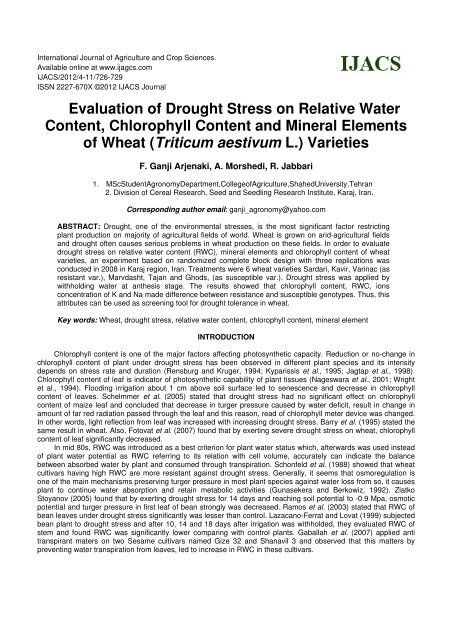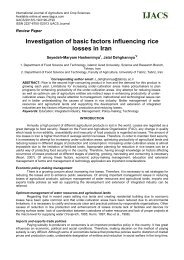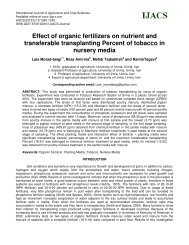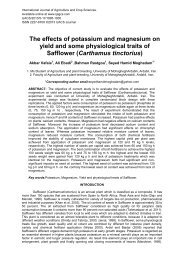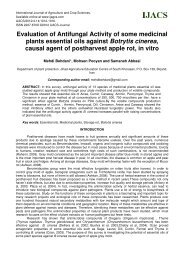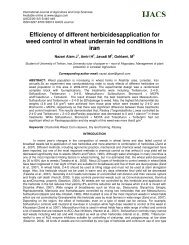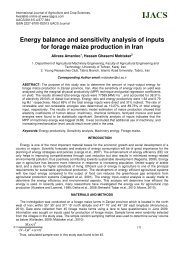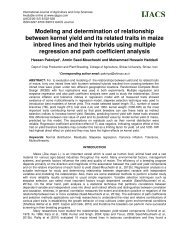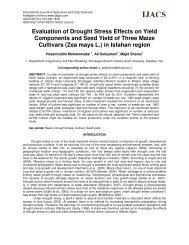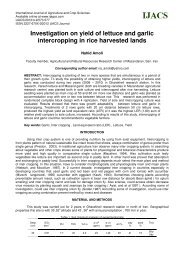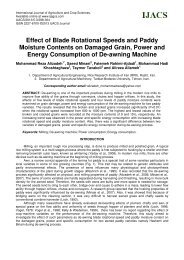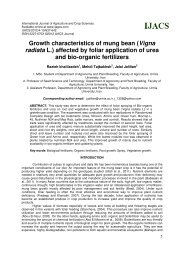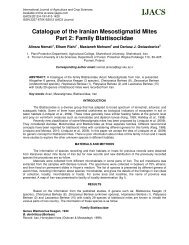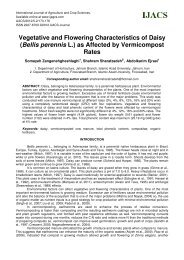Evaluation of Drought Stress on Relative Water Content, Chlorophyll ...
Evaluation of Drought Stress on Relative Water Content, Chlorophyll ...
Evaluation of Drought Stress on Relative Water Content, Chlorophyll ...
You also want an ePaper? Increase the reach of your titles
YUMPU automatically turns print PDFs into web optimized ePapers that Google loves.
Internati<strong>on</strong>al Journal <str<strong>on</strong>g>of</str<strong>on</strong>g> Agriculture and Crop Sciences.<br />
Available <strong>on</strong>line at www.ijagcs.com<br />
IJACS/2012/4-11/726-729<br />
ISSN 2227-670X ©2012 IJACS Journal<br />
<str<strong>on</strong>g>Evaluati<strong>on</strong></str<strong>on</strong>g> <str<strong>on</strong>g>of</str<strong>on</strong>g> <str<strong>on</strong>g>Drought</str<strong>on</strong>g> <str<strong>on</strong>g>Stress</str<strong>on</strong>g> <strong>on</strong> <strong>Relative</strong> <strong>Water</strong><br />
C<strong>on</strong>tent, <strong>Chlorophyll</strong> C<strong>on</strong>tent and Mineral Elements<br />
<str<strong>on</strong>g>of</str<strong>on</strong>g> Wheat (Triticum aestivum L.) Varieties<br />
F. Ganji Arjenaki, A. Morshedi, R. Jabbari<br />
1. MScStudentAgr<strong>on</strong>omyDepartment,College<str<strong>on</strong>g>of</str<strong>on</strong>g>Agriculture,ShahedUniversity,Tehran<br />
2. Divisi<strong>on</strong> <str<strong>on</strong>g>of</str<strong>on</strong>g> Cereal Research, Seed and Seedling Research Institute, Karaj, Iran.<br />
Corresp<strong>on</strong>ding author email: ganji_agr<strong>on</strong>omy@yahoo.com<br />
ABSTRACT: <str<strong>on</strong>g>Drought</str<strong>on</strong>g>, <strong>on</strong>e <str<strong>on</strong>g>of</str<strong>on</strong>g> the envir<strong>on</strong>mental stresses, is the most significant factor restricting<br />
plant producti<strong>on</strong> <strong>on</strong> majority <str<strong>on</strong>g>of</str<strong>on</strong>g> agricultural fields <str<strong>on</strong>g>of</str<strong>on</strong>g> world. Wheat is grown <strong>on</strong> arid-agricultural fields<br />
and drought <str<strong>on</strong>g>of</str<strong>on</strong>g>ten causes serious problems in wheat producti<strong>on</strong> <strong>on</strong> these fields. In order to evaluate<br />
drought stress <strong>on</strong> relative water c<strong>on</strong>tent (RWC), mineral elements and chlorophyll c<strong>on</strong>tent <str<strong>on</strong>g>of</str<strong>on</strong>g> wheat<br />
varieties, an experiment based <strong>on</strong> randomized complete block design with three replicati<strong>on</strong>s was<br />
c<strong>on</strong>ducted in 2008 in Karaj regi<strong>on</strong>, Iran. Treatments were 6 wheat varieties Sardari, Kavir, Varinac (as<br />
resistant var.), Marvdasht, Tajan and Ghods, (as susceptible var.). <str<strong>on</strong>g>Drought</str<strong>on</strong>g> stress was applied by<br />
withholding water at anthesis stage. The results showed that chlorophyll c<strong>on</strong>tent, RWC, i<strong>on</strong>s<br />
c<strong>on</strong>centrati<strong>on</strong> <str<strong>on</strong>g>of</str<strong>on</strong>g> K and Na made difference between resistance and susceptible genotypes. Thus, this<br />
attributes can be used as screening tool for drought tolerance in wheat.<br />
Key words: Wheat, drought stress, relative water c<strong>on</strong>tent, chlorophyll c<strong>on</strong>tent, mineral element<br />
INTRODUCTION<br />
<strong>Chlorophyll</strong> c<strong>on</strong>tent is <strong>on</strong>e <str<strong>on</strong>g>of</str<strong>on</strong>g> the major factors affecting photosynthetic capacity. Reducti<strong>on</strong> or no-change in<br />
chlorophyll c<strong>on</strong>tent <str<strong>on</strong>g>of</str<strong>on</strong>g> plant under drought stress has been observed in different plant species and its intensity<br />
depends <strong>on</strong> stress rate and durati<strong>on</strong> (Rensburg and Kruger, 1994; Kyparissis et al., 1995; Jagtap et al., 1998).<br />
<strong>Chlorophyll</strong> c<strong>on</strong>tent <str<strong>on</strong>g>of</str<strong>on</strong>g> leaf is indicator <str<strong>on</strong>g>of</str<strong>on</strong>g> photosynthetic capability <str<strong>on</strong>g>of</str<strong>on</strong>g> plant tissues (Nageswara et al., 2001; Wright<br />
et al., 1994). Flooding irrigati<strong>on</strong> about 1 cm above soil surface led to senescence and decrease in chlorophyll<br />
c<strong>on</strong>tent <str<strong>on</strong>g>of</str<strong>on</strong>g> leaves. Schelmmer et al. (2005) stated that drought stress had no significant effect <strong>on</strong> chlorophyll<br />
c<strong>on</strong>tent <str<strong>on</strong>g>of</str<strong>on</strong>g> maize leaf and c<strong>on</strong>cluded that decrease in turger pressure caused by water deficit, result in change in<br />
amount <str<strong>on</strong>g>of</str<strong>on</strong>g> far red radiati<strong>on</strong> passed through the leaf and this reas<strong>on</strong>, read <str<strong>on</strong>g>of</str<strong>on</strong>g> chlorophyll meter device was changed.<br />
In other words, light reflecti<strong>on</strong> from leaf was increased with increasing drought stress. Barry et al. (1995) stated the<br />
same result in wheat. Also, Fotovat et al. (2007) found that by exerting severe drought stress <strong>on</strong> wheat, chlorophyll<br />
c<strong>on</strong>tent <str<strong>on</strong>g>of</str<strong>on</strong>g> leaf significantly decreased.<br />
In mid 80s, RWC was introduced as a best criteri<strong>on</strong> for plant water status which, afterwards was used instead<br />
<str<strong>on</strong>g>of</str<strong>on</strong>g> plant water potential as RWC referring to its relati<strong>on</strong> with cell volume, accurately can indicate the balance<br />
between absorbed water by plant and c<strong>on</strong>sumed through transpirati<strong>on</strong>. Sch<strong>on</strong>feld et al. (1988) showed that wheat<br />
cultivars having high RWC are more resistant against drought stress. Generally, it seems that osmoregulati<strong>on</strong> is<br />
<strong>on</strong>e <str<strong>on</strong>g>of</str<strong>on</strong>g> the main mechanisms preserving turger pressure in most plant species against water loss from so, it causes<br />
plant to c<strong>on</strong>tinue water absorpti<strong>on</strong> and retain metabolic activities (Gunasekera and Berkowiz, 1992). Zlatko<br />
Stoyanov (2005) found that by exerting drought stress for 14 days and reaching soil potential to -0.9 Mpa, osmotic<br />
potential and turger pressure in first leaf <str<strong>on</strong>g>of</str<strong>on</strong>g> bean str<strong>on</strong>gly was decreased. Ramos et al. (2003) stated that RWC <str<strong>on</strong>g>of</str<strong>on</strong>g><br />
bean leaves under drought stress significantly was lesser than c<strong>on</strong>trol. Lazacano-Ferrat and Lovat (1999) subjected<br />
bean plant to drought stress and after 10, 14 and 18 days after irrigati<strong>on</strong> was withholded, they evaluated RWC <str<strong>on</strong>g>of</str<strong>on</strong>g><br />
stem and found RWC was significantly lower comparing with c<strong>on</strong>trol plants. Gaballah et al. (2007) applied anti<br />
transpirant maters <strong>on</strong> two Sesame cultivars named Gize 32 and Shanavil 3 and observed that this matters by<br />
preventing water transpirati<strong>on</strong> from leaves, led to increase in RWC in these cultivars.
Intl J Agri Crop Sci. Vol., 4 (11), 726-729, 2012<br />
There is no informati<strong>on</strong> available for the spatial distributi<strong>on</strong>s <str<strong>on</strong>g>of</str<strong>on</strong>g> micr<strong>on</strong>utrient in the growing leaves <str<strong>on</strong>g>of</str<strong>on</strong>g> grasses<br />
under drought c<strong>on</strong>diti<strong>on</strong>s and for the comparative resp<strong>on</strong>ses <str<strong>on</strong>g>of</str<strong>on</strong>g> different species to drought and salinity stresses<br />
(Yuncai e al., 2007). It is known that <str<strong>on</strong>g>of</str<strong>on</strong>g> metal i<strong>on</strong>s (paramagnetic i<strong>on</strong>s) play a significant role in the binding <str<strong>on</strong>g>of</str<strong>on</strong>g> water<br />
in plants (D. Joseps et al., 1996). K plays a critical role in the stomatal activity and water relati<strong>on</strong> <str<strong>on</strong>g>of</str<strong>on</strong>g> plants<br />
(Marchner, 1995; Mengel and Kirkby, 2001). The availability <str<strong>on</strong>g>of</str<strong>on</strong>g> K + to the plant decreases with decreasing soil water<br />
c<strong>on</strong>tent, due to the decreasing mobility <str<strong>on</strong>g>of</str<strong>on</strong>g> K + under these c<strong>on</strong>diti<strong>on</strong>s. The capacity <str<strong>on</strong>g>of</str<strong>on</strong>g> plants to maintain high<br />
c<strong>on</strong>centrati<strong>on</strong>s <str<strong>on</strong>g>of</str<strong>on</strong>g> k in their tissues seems to be useful trait to take into account in breeding genotypes for high<br />
tolerance to drought stress. In recent years, intracellular Ca 2+ has been found to regulate the resp<strong>on</strong>ses <str<strong>on</strong>g>of</str<strong>on</strong>g> the plant<br />
to drought and salinity and has also been implicated in the transducti<strong>on</strong> <str<strong>on</strong>g>of</str<strong>on</strong>g> drought- and salt-stress signals in plants,<br />
which play an essential role in osmoregulati<strong>on</strong> under these c<strong>on</strong>diti<strong>on</strong>s (Knight et al., 1997; Bartels and Sunker,<br />
2005). High Na + c<strong>on</strong>centrati<strong>on</strong> in the external soluti<strong>on</strong> cause a decrease in both K + and Ca 2+ c<strong>on</strong>centrati<strong>on</strong>s in the<br />
tissues <str<strong>on</strong>g>of</str<strong>on</strong>g> many plant species (Hu and Schmidhalter, 1997). This decrease could be due to the antag<strong>on</strong>ism <str<strong>on</strong>g>of</str<strong>on</strong>g> Na +<br />
and K + at uptake site in the roots, the effect <str<strong>on</strong>g>of</str<strong>on</strong>g> Na + <strong>on</strong> K + transport into the xylem (Lynch and Läunchli, 1984), or the<br />
inhibiti<strong>on</strong> <str<strong>on</strong>g>of</str<strong>on</strong>g> uptake processes (Suhayda et al., 1990). Little informati<strong>on</strong> is available <strong>on</strong> the effect <str<strong>on</strong>g>of</str<strong>on</strong>g> drought <strong>on</strong> Mg<br />
<str<strong>on</strong>g>of</str<strong>on</strong>g> plant. Yuncai Hu and Urs Schmidhalter (2005) stated that drought reduced Mg uptake.<br />
The objective <str<strong>on</strong>g>of</str<strong>on</strong>g> this research was to determine RWC, chlorophyll c<strong>on</strong>tent and mineral element <str<strong>on</strong>g>of</str<strong>on</strong>g> Wheat<br />
leaves under drought stress in Karaj regi<strong>on</strong>, Iran.<br />
MATERIALS AND METHODS<br />
In order to evaluate drought stress <strong>on</strong> relative water c<strong>on</strong>tent (RWC), chlorophyll c<strong>on</strong>tent and mineral element<br />
<str<strong>on</strong>g>of</str<strong>on</strong>g> 6 Wheat genotypes, an experiment based <strong>on</strong> randomized complete block design with three replicati<strong>on</strong>s was<br />
c<strong>on</strong>ducted in 2008 in Karaj regi<strong>on</strong>, Iran. Treatments were 6 Wheat genotypes (Sardari, Kavir, Tajan, Varinac,<br />
Marvdasht and Ghods) and drought stress was applied by wihholding water at anthesis stage. <strong>Chlorophyll</strong> c<strong>on</strong>tent<br />
was measured by chlorophyll meter device. In order to calculate RWC, leaf fresh weight samples were weighed,<br />
then were submerged in distilled water and finally were direct at 70ºC for 48 h and were weighed again. RWC was<br />
calculated according to Dhopte and Manuel (2002):<br />
RWC = (FW-DW/TW-DW) ×100<br />
Where, FW is fresh weight, DW is dry weight and TW is turger weight <str<strong>on</strong>g>of</str<strong>on</strong>g> leaf samples.<br />
Na and K were determined by flame photometry (Eppendorf Flex 6361 model). Ca and Mg were determined by<br />
potentiometric titrati<strong>on</strong> with EDTA soluti<strong>on</strong>.<br />
RESULTS AND DISCUSSION<br />
Change <str<strong>on</strong>g>of</str<strong>on</strong>g> Leaf <strong>Chlorophyll</strong><br />
Effect <str<strong>on</strong>g>of</str<strong>on</strong>g> drought stress was significant (p
Intl J Agri Crop Sci. Vol., 4 (11), 726-729, 2012<br />
should have high RWC. So, based <strong>on</strong> results, menti<strong>on</strong>ed genotypes which are classified as high and medium<br />
yielding genotypes in c<strong>on</strong>diti<strong>on</strong> <str<strong>on</strong>g>of</str<strong>on</strong>g> drought stress, should be <str<strong>on</strong>g>of</str<strong>on</strong>g> high-c<strong>on</strong>tent RWC. Decrease in RWC in plants<br />
under drought stress may depend <strong>on</strong> plant vigor reducti<strong>on</strong> and have been observed in many plants (Liu et al.,<br />
2002). Under water deficit, cell membrane subjects to changes such as penetrability and decrease in sustainability<br />
(Blokina et al., 2003). Microscopic investigati<strong>on</strong>s <str<strong>on</strong>g>of</str<strong>on</strong>g> dehydrated cells, revealed damages including cleavage in the<br />
membrane and sedimentati<strong>on</strong> <str<strong>on</strong>g>of</str<strong>on</strong>g> cytoplasm c<strong>on</strong>tent (Blackman et al., 1995). Probably, in these c<strong>on</strong>diti<strong>on</strong>s, ability to<br />
osmotic adjustment is reduced (Meyer and Boyer, 1981). It seems that c<strong>on</strong>centrati<strong>on</strong> <str<strong>on</strong>g>of</str<strong>on</strong>g> appropriate solutes to<br />
preserve membrane is not sufficient in this case.<br />
Treatments<br />
Resistant genotypes<br />
Sardari<br />
Kavir<br />
Varinac<br />
Susceptible genotypes<br />
Tajan<br />
Marvdasht<br />
Ghods<br />
Numbers with the same letters, have no significant difference to each other<br />
Table1. Mean comparis<strong>on</strong>s <str<strong>on</strong>g>of</str<strong>on</strong>g> effect <str<strong>on</strong>g>of</str<strong>on</strong>g> genotypes <strong>on</strong> measured trails in drought stress<br />
<strong>Chlorophyll</strong> c<strong>on</strong>tent<br />
49.34b<br />
51.89a<br />
50.07b<br />
45.01d<br />
46.98c<br />
44.26d<br />
Change <str<strong>on</strong>g>of</str<strong>on</strong>g> Mineral Elements<br />
This study showed that the difference in the mineral element between genotypes under drought stress<br />
c<strong>on</strong>diti<strong>on</strong> (Table 1). Based <strong>on</strong> the result, it was revealed that resistant genotypes, had the highest value <str<strong>on</strong>g>of</str<strong>on</strong>g> K and<br />
susceptible genotypes, had the highest value <str<strong>on</strong>g>of</str<strong>on</strong>g> Na. But differences in Ca and Mg between resistant and<br />
susceptible genotypes were erratic.<br />
Deficiencies <str<strong>on</strong>g>of</str<strong>on</strong>g> K and Mg cause marked decreases in photosynthetic C metabolism and utilizati<strong>on</strong> <str<strong>on</strong>g>of</str<strong>on</strong>g> fixed<br />
carb<strong>on</strong> (Mengel and Kirkby, 2001). Because <str<strong>on</strong>g>of</str<strong>on</strong>g> the distinct effects <str<strong>on</strong>g>of</str<strong>on</strong>g> Mg and K <strong>on</strong> photo-oxidative damage in plants<br />
grown under marginal c<strong>on</strong>diti<strong>on</strong>s, such as drought, chilling and salinity can be exacerbated when the soil supply <str<strong>on</strong>g>of</str<strong>on</strong>g><br />
mg or K is low. The beneficial effect <str<strong>on</strong>g>of</str<strong>on</strong>g> an adequate K supply was ascribed to the role <str<strong>on</strong>g>of</str<strong>on</strong>g> K in retranslocati<strong>on</strong> <str<strong>on</strong>g>of</str<strong>on</strong>g><br />
photo assimilates in roots, which c<strong>on</strong>tributed to better root growth under drought stress (Egilla et al., 2001). In light<br />
<str<strong>on</strong>g>of</str<strong>on</strong>g> these results it may be suggested that the protective roles <str<strong>on</strong>g>of</str<strong>on</strong>g> K against drought stress seem also to be related to<br />
their inhibitory effect <str<strong>on</strong>g>of</str<strong>on</strong>g> this element, plants become more sensitive to drought stress.<br />
CONCLUSIONS<br />
Survival and productivity <str<strong>on</strong>g>of</str<strong>on</strong>g> crop plants exposed to envir<strong>on</strong>mental stresses are dependent <strong>on</strong> their ability to<br />
develop adaptive mechanisms to avoid tolerate stress. Accumulating evidence suggests that the mineral nutriti<strong>on</strong>al<br />
status <str<strong>on</strong>g>of</str<strong>on</strong>g> plants greatly affects their ability to adapt to adverse envir<strong>on</strong>mental c<strong>on</strong>diti<strong>on</strong>s. In the present paper the<br />
role <str<strong>on</strong>g>of</str<strong>on</strong>g> the mineral nutriti<strong>on</strong>al status <str<strong>on</strong>g>of</str<strong>on</strong>g> resistant genotype or tolerant in their adaptati<strong>on</strong> to drought stress c<strong>on</strong>diti<strong>on</strong>s<br />
discussed. This study was following to find characters <str<strong>on</strong>g>of</str<strong>on</strong>g> resistant under drought stress and the results showed that<br />
chlorophyll c<strong>on</strong>tent, RWC, i<strong>on</strong>s c<strong>on</strong>centrati<strong>on</strong> <str<strong>on</strong>g>of</str<strong>on</strong>g> K and Na made difference between resistance and susceptible<br />
genotypes. Thus, this attributes can be used as screening tool for drought tolerance in Wheat.<br />
ACKNOWLEDGMENTS<br />
This study was supported by the Seed and Plant Improvement Institute, Karaj, Iran.<br />
REFERENCES<br />
Alizade A. 2002. SOIL, <strong>Water</strong> and Plants Relati<strong>on</strong>ship. 3 rd Edn., Emam Reza University Press, Mashhad, Iran, ISBN: 964-6582-21-4.<br />
Barry P, Evershed R, Young A, Prescott MC, Britt<strong>on</strong> G. 1992. Characterizati<strong>on</strong> <str<strong>on</strong>g>of</str<strong>on</strong>g> carotenoid acyl ester produced in drought-stressed barley<br />
seedlings. Phyto-Chemistry, 9: 3163-3168.<br />
Bartels D, Sunkar R. 2005. <str<strong>on</strong>g>Drought</str<strong>on</strong>g> and salt tolerance in plants. Criti. Rev. Plant Sci. 24, 23–58.<br />
Beeflink WG, Rozema J, Huiskes AEL. 1985. Ecology <str<strong>on</strong>g>of</str<strong>on</strong>g> Coastal Vegetati<strong>on</strong>. 2 nd Edn., W. Junk Publicati<strong>on</strong>. USA., ISBN: 9061935318, pp: 640.<br />
Blackman SA, Obendorf RL, Lepold AC. 1995. Desiccati<strong>on</strong> tolerance in developing soybean seeds: The role <str<strong>on</strong>g>of</str<strong>on</strong>g> stress proteins. Plant Physiol.,<br />
93: 630-638.<br />
Blokhina O, Virolainen E, Fagerstedt KV. 2003. Anti-oxidative damage and oxygen deprivati<strong>on</strong> stress. Ann. Bot., 91: 179-194.<br />
RWC<br />
74.43a<br />
79.96a<br />
72.2ab<br />
64.3bc<br />
73.2ab<br />
59.3c<br />
K<br />
5a<br />
5a<br />
5a<br />
3.75c<br />
2.5d<br />
3.9b<br />
Na<br />
4.16a<br />
2.5c<br />
4.16a<br />
3.66ab<br />
2.91bc<br />
2.83c<br />
Ca<br />
1.2a<br />
0.7c<br />
0.66c<br />
1b<br />
0.3d<br />
1.13ab<br />
Mg<br />
0.26c<br />
2.88a<br />
0.32c<br />
0.56bc<br />
0.92b<br />
0.29c
Intl J Agri Crop Sci. Vol., 4 (11), 726-729, 2012<br />
Joseph D, Srinivasan VT, Lal M. 1996. Sainis, Study <str<strong>on</strong>g>of</str<strong>on</strong>g> the effect <str<strong>on</strong>g>of</str<strong>on</strong>g> paramagnetic i<strong>on</strong>s <strong>on</strong> the water relaxati<strong>on</strong> time <str<strong>on</strong>g>of</str<strong>on</strong>g> wheat leaves by nuclear<br />
magnetic res<strong>on</strong>ance (NMR) and energy dispersive X-ray fluorescence (EDXRF) spectroscopy, J. Nucl. Agric. Biol. 25(3), 139–143.<br />
Dhopte AM, Manuel LM. 2002. Principles and Techniques for Plant Scientists. 1 st Edn., Updesh Purohit for Agribios (India), Odhpur, IBSN: 81-<br />
7754-116-1, pp: 373.<br />
Egilla JN, Davies FT, Drew MC. 2001. Effect <str<strong>on</strong>g>of</str<strong>on</strong>g> potassium <strong>on</strong> drought resistance <str<strong>on</strong>g>of</str<strong>on</strong>g> Hibiscus rosa-sinensis cv. Leprechaun: plant growth, leaf<br />
macro- and micr<strong>on</strong>utrient c<strong>on</strong>tent and root l<strong>on</strong>gevity. Plant Soil, 229: 213-224.<br />
Fotovat R, Valizadeh M, Toorehi M. 2007. Associati<strong>on</strong> between water-use-efficiency comp<strong>on</strong>ents and total chlorophyll c<strong>on</strong>tent (SPAD)in wheat<br />
(Triticum aestivum L.) under well-watered and drought stress c<strong>on</strong>diti<strong>on</strong>s. J. Food. Agric. Envir<strong>on</strong>., 5: 225-227.<br />
Foyer CH, Descourvieres P, Kunert KJ. 1994. Photo oxidative stress in plants. Plant. Physiol., 92: 696-717.<br />
Gaballah MS, Abou B, Leila H, El-Zeiny A, Khalil S. 2007. Estimating the performance <str<strong>on</strong>g>of</str<strong>on</strong>g> salt stressed sesame plant treated with<br />
antitranspirants. J. Applied Sci. Res., 3: 811-817.<br />
Gunasekera D, Berkowitz GA. 1992. <str<strong>on</strong>g>Evaluati<strong>on</strong></str<strong>on</strong>g> <str<strong>on</strong>g>of</str<strong>on</strong>g> c<strong>on</strong>trasting cellular-level acclimati<strong>on</strong> resp<strong>on</strong>ses to leaf water deficits in three wheat<br />
genotypes. Plant. Sci., 86: 1-12.<br />
Hu Y, Schmidhalter U. 1997. Interactive effects <str<strong>on</strong>g>of</str<strong>on</strong>g> salinity and macr<strong>on</strong>utrient level <strong>on</strong> wheat. 2. Compositi<strong>on</strong>. J. Plant Nutr. 20, 1169–1182.<br />
Hu Y, Schmidhalter U. 2005. <str<strong>on</strong>g>Drought</str<strong>on</strong>g> and salinity: Acopmparisi<strong>on</strong> their effect <strong>on</strong> mineral nutriti<strong>on</strong> <str<strong>on</strong>g>of</str<strong>on</strong>g> plants. J. Plant Nut. Soil Sci. 168, 541-549.<br />
Jagtap V, Bhargava S, Sterb P, Feierabend J. 1998. Comparative effect <str<strong>on</strong>g>of</str<strong>on</strong>g> water, heat and light stresses <strong>on</strong> photosynthetic reacti<strong>on</strong>s in<br />
Sorghum bicolor (L.) Moench. J. Exp. Bot., 49: 1715-1721.<br />
Knight H, Trewavas AJ, Knight MR. 1997. Calcium signaling in Arabidopsis thaliana resp<strong>on</strong>ding to drought and salinity. Plant J. 12, 1067–1078.<br />
Kyparissis A, Petropoulou Y, Manetas Y. 1995. Summer survival <str<strong>on</strong>g>of</str<strong>on</strong>g> leaves in a s<str<strong>on</strong>g>of</str<strong>on</strong>g>t-leaved shrub (Phlomis fruticosa L., Labiates) under<br />
Mediterranean field c<strong>on</strong>diti<strong>on</strong>s: Avoidance <str<strong>on</strong>g>of</str<strong>on</strong>g> photoinhibitory damage through decreased chlorophyll c<strong>on</strong>tents. J. Exp. Bot., 46:1825-<br />
1831.<br />
Lawlor DW, Cornic G. 2002. Photosynthetic carb<strong>on</strong> assimilati<strong>on</strong> and associated metabolism in relati<strong>on</strong> to water deficits in higher plants. Plant<br />
Cell Envir<strong>on</strong>., 25: 275-24.<br />
Lazacano-Ferrat I, Lovat CJ. 1999. Relati<strong>on</strong>ship between relative water c<strong>on</strong>tent, nitrogen pools, and growth <str<strong>on</strong>g>of</str<strong>on</strong>g> Phaseolus vulgaris L. and P.<br />
acutifoolius A. Gray during water deficit. Crop. SCI., 39: 467-475.<br />
Lessani H, Mojtahedi M. 2002. Introducti<strong>on</strong> to Plant Physiology (Translati<strong>on</strong>). 6 th Edn., Tehran University press, Iran, ISBN: 964-03-3568-1, pp:<br />
726.<br />
Liu Y, Fiskum G, Schubert D. 2002. Generati<strong>on</strong> <str<strong>on</strong>g>of</str<strong>on</strong>g> reactive oxygen species by mitoch<strong>on</strong>drial electr<strong>on</strong> transport chain. J. Neurochem., 80: 780-<br />
787.<br />
Lynch J, Läuchli A. 1984. Potassium-transport in salt-stressed barley roots. Planta 161, 295–301.<br />
Marschner H. 1995. Mineral nutriti<strong>on</strong> <str<strong>on</strong>g>of</str<strong>on</strong>g> higher plants. 2 nd Editi<strong>on</strong>. Academic Press, San Diego. 889 pp.<br />
Mengel K, Kirkby EA. 2001. Principles <str<strong>on</strong>g>of</str<strong>on</strong>g> plant nutriti<strong>on</strong>. 5 th editi<strong>on</strong>. Kluwer Academic Publishers, Dordrecht. 848 pp.<br />
Mensah JK, Obad<strong>on</strong>i BO, Eroutor PG, Onome-Irieguna F. 2006. Simulated flooding and drought effects <strong>on</strong> germinati<strong>on</strong>, growth and yield<br />
parameters <str<strong>on</strong>g>of</str<strong>on</strong>g> Sesame (Seasamum indicum L.). Afr. J. Biotechnol., 5: 1249-1253.<br />
Meyer RF, Boyer JS. 1981. Osmoregulati<strong>on</strong> solute distributi<strong>on</strong> and growth in soybean seedlings having low water potentials. Planta, 151: 482-<br />
489.<br />
Mirn<str<strong>on</strong>g>of</str<strong>on</strong>g>f N. 1993. The role <str<strong>on</strong>g>of</str<strong>on</strong>g> active oxygen in the resp<strong>on</strong>se <str<strong>on</strong>g>of</str<strong>on</strong>g> plants to water deficit and desiccati<strong>on</strong>. New Phytol., 125: 27-58.<br />
M<strong>on</strong>tagu KD, WOO KC. 1999. Recovery <str<strong>on</strong>g>of</str<strong>on</strong>g> tree photosynthetic capacity from seas<strong>on</strong>al drought in the wet-dry tropics: The role <str<strong>on</strong>g>of</str<strong>on</strong>g> phyllode and<br />
canopy processes in Acacia auriculiformis. Aust. J. Plant Physiol., 26: 135-145.<br />
Nageswara RRC, Talwar HS, Wright GC. 2001. Rapid assessment <str<strong>on</strong>g>of</str<strong>on</strong>g> specific leaf area and leaf nitrogen in peanut (Arachis hypogaea L.) using<br />
chlorophyll meter. J. Agr<strong>on</strong>. Crop Sci., 189: 175-182.<br />
Nilsen ET, Orcutt DM. 1996. Physiology <str<strong>on</strong>g>of</str<strong>on</strong>g> Plants Under <str<strong>on</strong>g>Stress</str<strong>on</strong>g>, Abiotic Factors. 2 nd Edn., John Wiley and S<strong>on</strong>s Inc., New York, ISBN:<br />
0471170089, pp: 689.<br />
Ramos MLG, Pars<strong>on</strong>s R, Sprent JI, Games EK. 2003. Effect <str<strong>on</strong>g>of</str<strong>on</strong>g> water stress <strong>on</strong> nitrogen fixati<strong>on</strong> and nodule structure <str<strong>on</strong>g>of</str<strong>on</strong>g> comm<strong>on</strong> bean. Pesq.<br />
Agropec. Brasilia., 38: 339-347.<br />
Rensburg LV, Kruger GHJ. 1994. <str<strong>on</strong>g>Evaluati<strong>on</strong></str<strong>on</strong>g> <str<strong>on</strong>g>of</str<strong>on</strong>g> comp<strong>on</strong>ents <str<strong>on</strong>g>of</str<strong>on</strong>g> oxidative stress metabolism for use in selecti<strong>on</strong> <str<strong>on</strong>g>of</str<strong>on</strong>g> drought tolerant cultivars <str<strong>on</strong>g>of</str<strong>on</strong>g><br />
Nicotiana tabacum L. J. Plant Physiol., 143:730-737.<br />
Schlemmer MR, francis DD, Shanahan JF, Schepers JS. 2005. Remotely measuring chlorophyll c<strong>on</strong>tent in corn leaves with differing nitrogen<br />
levels and relative water c<strong>on</strong>tent. Agr<strong>on</strong>. J., 97:106-112.<br />
Sch<strong>on</strong>feld MA, Johns<strong>on</strong> RC, Carwer BF, Mornhinweg DW. 1988. <strong>Water</strong> relati<strong>on</strong>s in winter wheat as drought resistance indicators. Crop. Sci., 28:<br />
526-531.<br />
Suhayda CG, Giannini JL, Briskin DP, Shann<strong>on</strong> MC. 1990. Electrostatic changes in Lycopersic<strong>on</strong> esculentum root plasma membrane resulting<br />
from salt stress. Plant Physiol. 93, 471–478.<br />
Wright GC, Nageswara RC, Farquhar GD. 1994. <strong>Water</strong> use efficiency and carb<strong>on</strong> isotop discriminati<strong>on</strong> in peanut under water deficit c<strong>on</strong>diti<strong>on</strong>s.<br />
Crop SCI., 34: 92-97.<br />
Xian-He J, Wang J, Guo H, Liang F. 1995. Effects <str<strong>on</strong>g>of</str<strong>on</strong>g> water stress <strong>on</strong> photochemical functi<strong>on</strong> and protein metabolism <str<strong>on</strong>g>of</str<strong>on</strong>g> photosystem II in wheat<br />
leaves. Physiol Plant., 93: 771-777.<br />
Yuncai H, Burucs Z, Tucher S, Schmidhalter U. 2007. Short-term effects <str<strong>on</strong>g>of</str<strong>on</strong>g> drought and salinity <strong>on</strong> mineral nutrient distributi<strong>on</strong> al<strong>on</strong>g growing<br />
leaves <str<strong>on</strong>g>of</str<strong>on</strong>g> maize seedlings. Envir<strong>on</strong>mental and Experimental Botany, 60: 268-275.<br />
Zlatko Stoyanov Z. 2005. Effect <str<strong>on</strong>g>of</str<strong>on</strong>g> water stress <strong>on</strong> leaf water relati<strong>on</strong>s <str<strong>on</strong>g>of</str<strong>on</strong>g> young bean. J. Cent. Eur. Agric., 6: 5-14.


